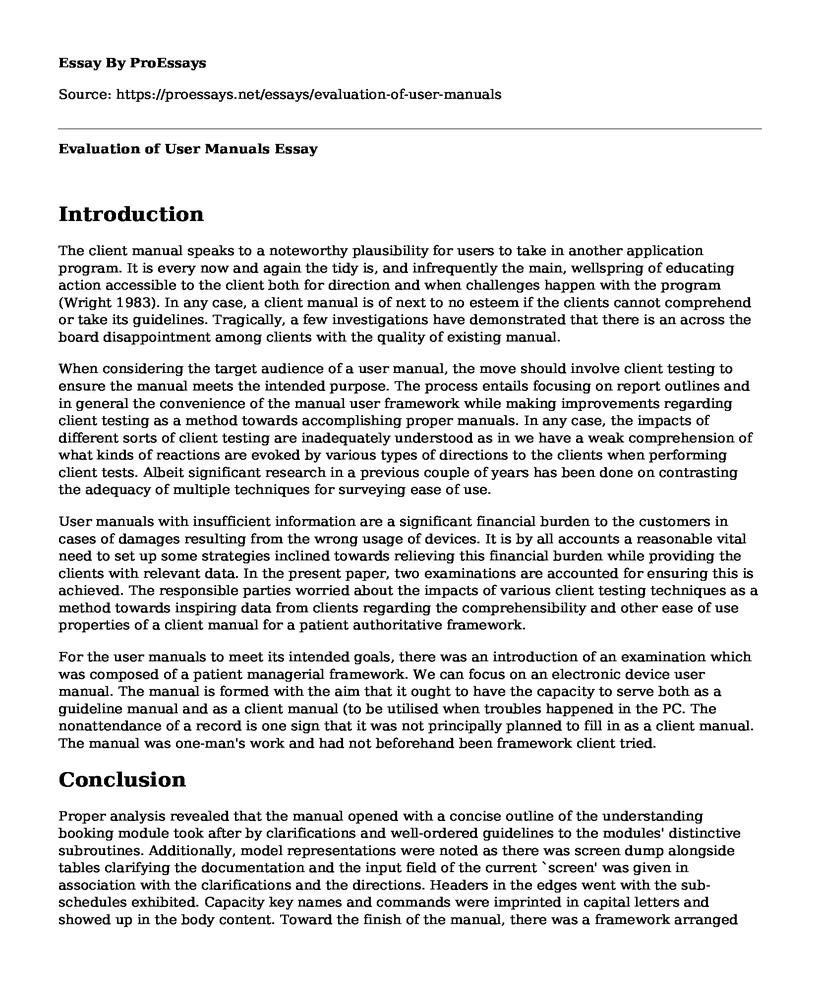Introduction
The client manual speaks to a noteworthy plausibility for users to take in another application program. It is every now and again the tidy is, and infrequently the main, wellspring of educating action accessible to the client both for direction and when challenges happen with the program (Wright 1983). In any case, a client manual is of next to no esteem if the clients cannot comprehend or take its guidelines. Tragically, a few investigations have demonstrated that there is an across the board disappointment among clients with the quality of existing manual.
When considering the target audience of a user manual, the move should involve client testing to ensure the manual meets the intended purpose. The process entails focusing on report outlines and in general the convenience of the manual user framework while making improvements regarding client testing as a method towards accomplishing proper manuals. In any case, the impacts of different sorts of client testing are inadequately understood as in we have a weak comprehension of what kinds of reactions are evoked by various types of directions to the clients when performing client tests. Albeit significant research in a previous couple of years has been done on contrasting the adequacy of multiple techniques for surveying ease of use.
User manuals with insufficient information are a significant financial burden to the customers in cases of damages resulting from the wrong usage of devices. It is by all accounts a reasonable vital need to set up some strategies inclined towards relieving this financial burden while providing the clients with relevant data. In the present paper, two examinations are accounted for ensuring this is achieved. The responsible parties worried about the impacts of various client testing techniques as a method towards inspiring data from clients regarding the comprehensibility and other ease of use properties of a client manual for a patient authoritative framework.
For the user manuals to meet its intended goals, there was an introduction of an examination which was composed of a patient managerial framework. We can focus on an electronic device user manual. The manual is formed with the aim that it ought to have the capacity to serve both as a guideline manual and as a client manual (to be utilised when troubles happened in the PC. The nonattendance of a record is one sign that it was not principally planned to fill in as a client manual. The manual was one-man's work and had not beforehand been framework client tried.
Conclusion
Proper analysis revealed that the manual opened with a concise outline of the understanding booking module took after by clarifications and well-ordered guidelines to the modules' distinctive subroutines. Additionally, model representations were noted as there was screen dump alongside tables clarifying the documentation and the input field of the current `screen' was given in association with the clarifications and the directions. Headers in the edges went with the sub-schedules exhibited. Capacity key names and commands were imprinted in capital letters and showed up in the body content. Toward the finish of the manual, there was a framework arranged stream outline depicting the structure of the program module...
Cite this page
Evaluation of User Manuals. (2022, May 22). Retrieved from https://proessays.net/essays/evaluation-of-user-manuals
If you are the original author of this essay and no longer wish to have it published on the ProEssays website, please click below to request its removal:
- SWOT Analysis for Hotel Example: Sheraton Hotel & Resorts
- Analyzing the Internal Organization Paper Example
- Essay on Successful Branding: Essential for Business Growth & Market Share
- Paper Example on AMC Aims to Provide Movie-Going Experience of Highest Quality
- Airbnb's Success: From Start-Up to Enterprise Through Strategic Marketing - Essay Sample
- Essay Example on Global Business Dynamics: My Experience with Samsung Group
- Essay Sample on ToolTopia's Transformation: Navigating Strategic Shifts in Online Retail







